Are you a Quiet Speculation member?
If not, now is a perfect time to join up! Our powerful tools, breaking-news analysis, and exclusive Discord channel will make sure you stay up to date and ahead of the curve.
The verdict's all but in: new kid on the block Death's Shadow Jund is Modern's new deck to beat. Death's Shadow's ascent to boogeyman status carries metagame-wide implications and emphasizes some of Modern's quirks. Today, we'll explore why Death's Shadow Jund is so good, what the deck means for the format, and whether other decks should recruit the massive Avatar for their own purposes.
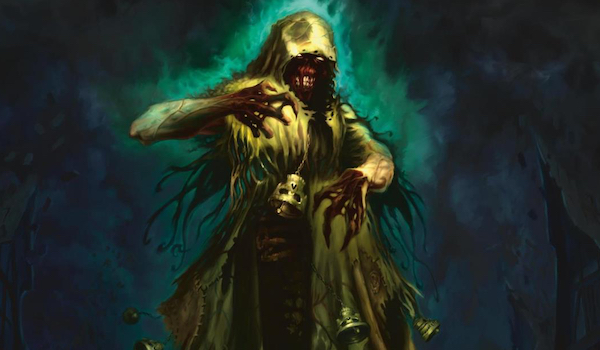
Breaking Down Death's Shadow
Death's Shadow itself has rarely seen Modern play outside of all-in aggro-combo decks. That changed near the end of Probe's Modern lifespan, when interactive Death's Shadow decks started putting up results online. Why is Death's Shadow suddenly seeing play in aggro-control decks, and what does it do for those decks? Let's find out!
[wp_ad_camp_1]
Tempo-Terrific
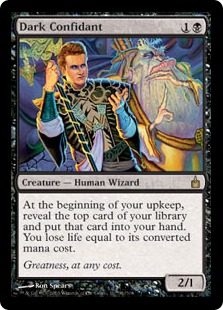 I've written before about how Modern is a format that rewards tempo and laughs at card advantage. To summarize, players put up far better results in the format when they throw their cards away to kill opponents than when they durdle around sniffing out two-for-ones. Some examples: Esper Charm can't manage to put up results despite the printing of Fatal Push, Collective Brutality continues to excel in black decks of all flavors, and Simian Spirit Guide even sees play in Zoo decks these days.
I've written before about how Modern is a format that rewards tempo and laughs at card advantage. To summarize, players put up far better results in the format when they throw their cards away to kill opponents than when they durdle around sniffing out two-for-ones. Some examples: Esper Charm can't manage to put up results despite the printing of Fatal Push, Collective Brutality continues to excel in black decks of all flavors, and Simian Spirit Guide even sees play in Zoo decks these days.
Our most recent example: Dark Confidant doesn't hold a candle to Death's Shadow. Why draw a bunch of cards when you can just kill your opponent? Modern's most persistent question proves as relevant as ever in this Death's Shadow metagame. Trading extra cards for extra damage is exactly what decks want to do in this format, and since the rediscovery of Death's Shadow, Modern's most powerful and interactive strategy gets to do just that.
Perfectly Proactive
In Three's Company: Exploring Metagame Parameters, I discussed the three factors Modern decks need to succeed: proactivity, interactivity, and consistency. Many Modern strategies specialize in two components and all but ignore the third, such as Ad Nauseam (highly proactive and consistent, but totally uninteractive). Others still find themselves enacting each component to a degree, but specializing in none, such as Merfolk.
Modern's winningest legal decks tend to share a key feature. From Three's Company:
Jund is a highly interactive, relatively proactive, relatively consistent deck. Bant Eldrazi is a highly proactive, relatively interactive, relatively consistent deck. These two decks specialize in a component each (respectively, interaction and proactivity), but don’t do so at the cost of giving up too much of the other two. The ability to maintain all components while perfecting one makes them some of the best decks in the format.
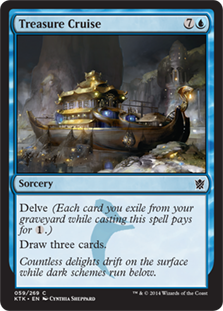 Death's Shadow makes Jund highly proactive. The combination of Street Wraith, Mishra's Bauble, Traverse the Ulvenwald, and incredible redundancy also make it highly consistent. It's no wonder Death's Shadow Jund puts up enviable numbers—the deck excels at all three components!
Death's Shadow makes Jund highly proactive. The combination of Street Wraith, Mishra's Bauble, Traverse the Ulvenwald, and incredible redundancy also make it highly consistent. It's no wonder Death's Shadow Jund puts up enviable numbers—the deck excels at all three components!
I'm not one to incite any ban mania, but I will say that the other holy trinity decks (at once highly proactive, interactive, and consistent) Modern has seen are now gone from the format. Treasure Cruise Delver, Eye of Ugin Eldrazi, and Deathrite/Bloodbraid Jund all qualify. Only time will tell if Modern manages to police Death's Shadow strategies of its own accord, but the deck is certainly very strong, and in my opinion far and away the best deck in the format.
Metagame Impacts
The arrival of a holy trinity deck to Modern obviously implies some metagame changes. Here are the ones I expect we'll see the soonest.
The Death of Jund
...Or, of Jund as we know it—gone are the days of 4 Confidant, 4 Liliana and a spattering of flavorful four-drops. In adopting Death's Shadow, Jund gives up some points against midrange (on paper, at least) for a huge edge in all linear matchups by swinging toward the aggro dot on the metagame spectrum. The biggest win here for Jund lies in the big-mana department; slugging through pushed colorless bombs has always been Jund's bane against decks like Tron, but Death's Shadow helps it kill quickly and reliably before those bombs come online.
As for giving up points against midrange, I mean that Death's Shadow Jund has fewer threats to work with. Removal-heavy matchups might be annoying for a deck without Raging Ravine or value-generating top-end threats. As logical as this point may sound, the issue has not bothered Death's Shadow Jund thus far. Bullets like Ranger of Eos and sideboard plans like 4 Lingering Souls (for which splashing is trivial) effectively "draw" tons of cards against the correct decks, and that's assuming Death Shadow Jund's hyper-consistent discard-into-enormous-threat plan falls through. All those Inquisitions add up fast in the Fatal Push mirror.
About those eight discard spells: the Jund decks of old tended to max out at eight discard spells, often favoring a 4 Inquisition/2 Thoughtseize split. Discard is awesome early, but loses relevance once the game progresses to the late-game state Jund aspires to. Since Death's Shadow Jund kills opponents so quickly, it aspires to no such late-game, and can benefit from the full discard suite without suffering drawbacks.
Despite Jund decreasing in metagame presence, some BGx players will undoubtedly stick to their midrange guns. Those players are likely to play Abzan. Lingering Souls, Path to Exile, Liliana of the Veil, and Fatal Push all match up well against Death's Shadow Jund, while Lightning Bolt does... well, nothing. The arguments for playing Abzan Midrange over Death's Shadow Jund seem clear enough, but I'm not sure they justify playing what's still, in essence, a worse BGx deck against Modern's wide-open field.
The Waning of Big Mana
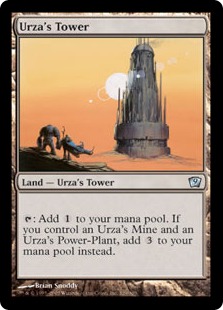 The main draw to big mana in Modern is its great midrange matchup. Decks like Titan Shift and GR Tron go way over the top of synergy-smashing goodstuff decks like Jund, which has historically commanded ample shares in Modern.
The main draw to big mana in Modern is its great midrange matchup. Decks like Titan Shift and GR Tron go way over the top of synergy-smashing goodstuff decks like Jund, which has historically commanded ample shares in Modern.
Until recently, BGx decks only scraped by against big mana when they managed to land enough early threats to close out games before Wurmcoils and Ugins started hitting the board. With Death's Shadow speeding Jund up enough that it can reliably kill big mana fast enough, Urza's Tower and friends are likely to lose some footing in the coming metagame.
The Rise of Bant Eldrazi
Big-mana decks, especially Valakut-based ones, decimate Bant Eldrazi. Those decks are sure to drop in share, and Bant Eldrazi happens to boast a defensible Death's Shadow matchup thanks to Drowner of Hope, Eldrazi Displacer, Path to Exile, and Engineered Explosives (not to mention hosers like Rest in Peace from the sideboard).
We saw Bant Eldrazi beat Death's Shadow Jund to a pulp on stream last weekend. Now standing to lose a primary predator, Bant Eldrazi looks better than ever.
Removal Shifts
With any metagame change, a format's blue-chip removal spells change. This has not happened a lot in Modern, where Bolt and Path have historically been way stronger than any other option (although we have seen some push-pull between the red and white instants depending on the season). With Fatal Push in the mix, and the top creature deck happening to dodge Modern's best card, things get more interesting.
Less Bolt
Splinter Twin has been gone for over a year. During that time, Jund has reigned supreme as Modern's premier Lightning Bolt deck, and by extension, its anti-aggro-combo policeman. While Death's Shadow Jund flies that policeman banner proud, it doesn't actually play Lightning Bolt, opting instead for a removal suite of Fatal Push and Tarfire (I never thought we'd see the day!). And Bolt itself happens to be uniquely terrible against Death's Shadow Jund.
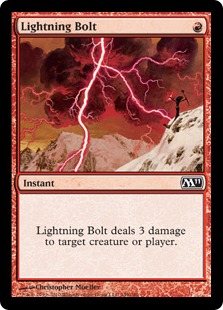 Modern's premier Bolt decks become, then, Grixis Control and Grixis Delver (and, presumably, Grixis Shadow). These Grixis decks combine for a miserable metagame share compared to that of Death's Shadow Jund, meaning we may soon enter a Modern era much kinder to x/3s than those before it. The three-toughness creatures most likely to enjoy a boost in viability are those that are already Modern-playable, namely Smuggler's Copter, Wild Nacatl, Eldrazi Displacer, Winding Constrictor, Spell Queller, and perhaps even Reflector Mage, an interesting candidate in a metagame full of decks with only two actual threats.
Modern's premier Bolt decks become, then, Grixis Control and Grixis Delver (and, presumably, Grixis Shadow). These Grixis decks combine for a miserable metagame share compared to that of Death's Shadow Jund, meaning we may soon enter a Modern era much kinder to x/3s than those before it. The three-toughness creatures most likely to enjoy a boost in viability are those that are already Modern-playable, namely Smuggler's Copter, Wild Nacatl, Eldrazi Displacer, Winding Constrictor, Spell Queller, and perhaps even Reflector Mage, an interesting candidate in a metagame full of decks with only two actual threats.
That said, this is still Modern, and you never know what you'll encounter. Lightning Bolt has a ton of random applications, such as killing a Scavenging Ooze with one counter or a planeswalker with three loyalty. Sometimes, one extra point of damage makes all the difference.
More Push
Not only is Fatal Push the easiest removal spell for Death's Shadow decks to employ—it's flexible, cheap, nearly unconditional, and on-color—it's the best removal spell against Death's Shadow Jund, killing every creature in the deck without revolt. Since Death's Shadow's speed encourages players to run creatures efficient enough to make it to the battlefield in the first place, Push also becomes better against Modern's other creature decks.
Creatures that cost five or more mana, of course, are totally immune to Fatal Push. The biggest winners in the coming metagame will avoid both Push and Tarfire (Reality Smasher, Hooting Mandrills, Tasigur, the Golden Fang, Zealous Conscripts) , and the biggest losers will die to both cards at a parity loss (Steel Overseer, Lord of Atlantis, Leonin Arbiter, Dark Confidant).
Brewing Sultai Shadow
I'm convinced that Death's Shadow has applications outside of the Jund decks we've seen thus far. Half a year ago, I proposed a Sultai list leveraging the disruptive efficacy of Thoughtseize, Dismember, and Stubborn Denial alongside the heavy-hitting threat suite of Death's Shadow, Tarmogoyf, and Grim Flayer.
At the time, there was little reason to play an interactive Death's Shadow deck instead of the combo-focused Kiln Fiend or Become Immense versions, which Gitaxian Probe enabled admirably. Currently, the opposite is true, as interactive Death's Shadow decks proudly sit atop the format. With Fatal Push now available, as well as new knowledge about the strength of eight discard spells in a deck with huge beaters, I decided to revisit Sultai Shadow.
Sultai Shadow, by Jordan Boisvert
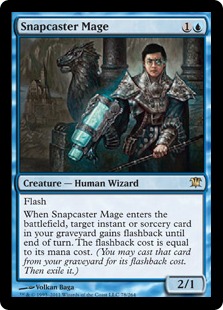
In With the New
This deck for the most part sticks to the tried-and-true Death's Shadow Jund core, but becomes even more focused. It trades utility cards like Temur Battle Rage, Kolaghan's Command, Ghor-Clan Rampager, and Liliana of the Veil for Snapcaster Mage and Stubborn Denial. These changes aim to shore up Death's Shadow Jund's worst matchups.
Snapcaster pulls double duty in this deck, adding resilience against removal-heavy strategies and disruption against other creature decks and linear decks. Since Snapcaster can flash back Traverse the Ulvenwald, it's essentially an extra threat in midrange matchups, fulfilling a role similar to that of Kolaghan's Command. No Tarfire means maxing out on Fatal Push, which works to our benefit in the pseudo-mirror. Here, Snapcaster combines with our four Pushes to keep enemy Goyfs and Shadows off the table forever.
Finally, Snapcaster Mage is a Traverse-searchable counterspell, flashing back Stubborn Denial to halt game-winning plays. Denial takes Death's Shadow's combo matchups from okay to fantastic, as well as pulling weight in the mirror (by countering Push, Thoughtseize, or Traverse) and against midrange (by countering planeswalkers, permission, lock pieces, or removal). I've posted a positive win rate so far against supposed Death's Shadow slayer RW Prison with this build, in no small part thanks to Snap-Deny.
Out With the Old
As for the cuts, ramping up on Push compensates for Tarfire's absence, as 5/6 is about as big as we need Tarmogoyf in this format anyway. Losing Temur Battle Rage is actually the most impactful of the changes, since half the Death's Shadow Jund decks don't even play Ghor-Clan Rampager.
The least subtle aspect of Temur Battle Rage: it allows Death's Shadow Jund to close games out faster against linear decks, especially of the big-mana and combo varieties. Sultai Shadow compensates for lacking this plan with Stubborn Denial, which punishes those decks for building gameplans around expensive noncreature spells.
Emma Handy noted this week that the combo element of Temur Battle Rage allows Death's Shadow Jund to leverage a tempo advantage on fear, like Splinter Twin could. That advantage is indeed powerful when realized, and aggro-combo-control has historically succeeded in Modern because of it. But Handy also concedes that towards the end of Twin's Modern reign, players realized how to negate it: to ignore the threat of the combo more often.
It's only a matter of time before they learn this about Temur Battle Rage, and the card loses its luster in the deck. The costs of including Rage in Death's Shadow Jund are very real: it's unsearchable and therefore unreliable, it plays badly from behind, and it doesn't directly contribute to the board state. On the other hand, perhaps enough Death's Shadow decks will hold onto Rage that red-featuring builds without it can still benefit from threatening the combo, as with Blood Moon in blue-red decks that fetch a lot of basics.
"Almost Dead:" The New "Alive and Kicking"
It seems to me so far like Death's Shadow may be the Delver of Secrets Modern has always wanted, as it combines well with the best disruption in the format (Thoughtseize, Fatal Push) and doesn't die to literally everything, an important quality in such a removal-loaded format. Shadow slots into disruptive, consistent shells that players can adjust for specific metagames, either by adding more removal, more permission, more threats, or even more cantrips—I couldn't fit Grim Flayer or Serum Visions into this Sultai build, but those cards may have a place in the archetype somewhere.
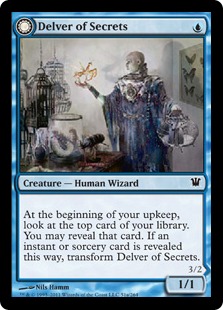 The Jund build does seem excellent to me, and appears to have the tools to deal with most everything. I still expect to see other Death's Shadow strategies crop up in Modern, including one optimized deck in blue given Snap-Push's strength in the mirror. We've seen Grixis Shadow make some waves so far, and Ryan Overturf placed 4th in a Star City Games Classic last weekend with a set of Shadows in his Grixis Delver deck.
The Jund build does seem excellent to me, and appears to have the tools to deal with most everything. I still expect to see other Death's Shadow strategies crop up in Modern, including one optimized deck in blue given Snap-Push's strength in the mirror. We've seen Grixis Shadow make some waves so far, and Ryan Overturf placed 4th in a Star City Games Classic last weekend with a set of Shadows in his Grixis Delver deck.
Considering how simple it is to splash a fourth color in fetch-heavy decks, we may observe a veritable rainbow of Death's Shadow diversity in the coming weeks. I know I'll be watching closely. It's an exciting time to be at 3 life!





Have you considered cutting 1 snapcaster, 1 fatal push and 1 or 2 stubborn denial for 4x thought scour in your Sultai build? When you cut tarfire from the deck, you are going to less reliably reach delirium for Traverse, which is actually the biggest reason to be playing red. The addition of thought scour, to some degree remedies that. The other option is to play something like Architects of Will as a 1 or 2 of. Something that GerryT has touched upon when he pondered whether the Death’s Shadow shell can add a color other than red.
Further, when you have thought scour and snapcaster in your deck, it allows you to run more one-ofs for more specific situations. So instead of playing:
3x Denial, 1x Decay, 1x Dismember, you could instead play, 1x denial, 1x decay, 1x dismember, 1x dispel, 1x collective brutality… or something along those lines.
Finally, thought scour allows you to run 18 or (maybe) even 17 lands because you essentially will have 12 cantrips in the deck instead of the 8 that the original shell provides.
I can see cutting a Denial, but Scour has never been great for enabling delirium on its own in my experience. Will have to test a lot more before drawing more conclusions.
I think the more saavy reaction to the reveal of Fatal Push was how it was ineffective against ramp and delve creatures, and so it was not an auto-4 of in decks with black. This deck may change that. Conversely…it seems like go-wide strategies that are not super vulnerable to discard would be effective, like Affinity and Elves. Living End makes sense as a counterpick as well – maindeck Kari Zev’s expertise throws a giant death shadow back at the opponent or let’s you play a living end to wipe the board while attacking the shadow deck’s 3-4 color manabase.
Basically I just want to play living end.
Go for it! Modern is all about playing your favorite strategy. But I don’t love Living End’s odds against a deck with 8 Thoughtseizes, mainboard Street Wraiths, creatures that dwarf yours without going wide, and Surgicals in the side…. Remember that DS changes his p/t when you steal him, too.
Blue offers basically nothing in your list that couldn’t be done better with white (or just going deeper into green–which then opens up a ton of other options main and post-board. Souls, path, apostle’s blessing, stony silence, silence itself even seems like a better sideboard card than ceremonious rejection.
Why Blue? Day’s undoing?
This was my big fear with going blue—are the options from a white splash in Jund as effective? I’d say in the short-term, Jund is definitely better positioned. Once the deck catches on a bit more, people learn to get around TBR, and players start sleeving up natural predators to Death’s Shadow, Snap (for the mirror/removal decks) and Denial (for combo/removal decks) may be worth more exploration.
You can actually read more about these cards in the article
Are you worried that death shadow might be too good? I dont advocate a ban, its far too early to tell, but I feel like it wont be hard to justify a ban. I mean, wizards did ban G-probe largely due to death shadow in particular, and if the deck has gotten more powerful, I feel like their sentiments against it will remain
I don’t think it’s better than Goyf, and that’s been legal for a long time. As always, bans will come down to metagame share and win percentage, since there’s no fear of DSJ ending a crazy amount of games before turn four. I think it’s premature to think about these factors without more numbers.
Ryan Overturf’s list looks similar to a list I ran for a second place finish in a pptq, it does still have a massive weakness to removal heavy decks. Death’s Shadow Jund uses a rebuy mechanic that shores up that problem. I feel like a mix of Grixis Death’s Shadow and Jund is a way to go, with spells like K Command and Lili last hope this should be a great list.
Snap-Traverse is pretty similar to Command in the BUG decks. But Command and LTLH might be just better at this. I’ll have to put in more reps to be sure.
FYI, Ryan Overturf X/3 dropped out of the main event with the same deck too.
That doesn’t make his deck bad. Everyone can have a crummy run. Of course, everyone can also run hot. He did take 4th at the Classic though, which gives me hope for Ryan’s list. Only time will tell if he got unlucky early or just lucky later.
Your perspective of the deck’s strengths as deriving from a strong proactive game plan plus a strong reactive game plan plus good consistency is the most succinct and trenchant analysis of this build I’ve read. I enjoy that this kind of thought process is much more useful than a case-by-case type analysis, e.g. “It’s better than Jund because it’s faster so therefore it’s better against Tron” which is where most commentators I’ve read have been going. Your article also gives me a tool to consider any other deck through the same lens, so many thanks for the framework.
It was nice to meet you a few weeks ago in Boston, best of luck to you.
Whoops, read “interactive” for “reactive” above.
Thanks for the comment Nat! See you around if you ever come back.